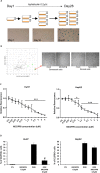Nociceptin/orphanin FQ opioid receptor (NOP) selective ligand MCOPPB links anxiolytic and senolytic effects
- PMID: 34820764
- PMCID: PMC8612119
- DOI: 10.1007/s11357-021-00487-y
Nociceptin/orphanin FQ opioid receptor (NOP) selective ligand MCOPPB links anxiolytic and senolytic effects
Abstract
Accumulation of senescent cells may drive age-associated alterations and pathologies. Senolytics are promising therapeutics that can preferentially eliminate senescent cells. Here, we performed a high-throughput automatized screening (HTS) of the commercial LOPAC®Pfizer library on aphidicolin-induced senescent human fibroblasts, to identify novel senolytics. We discovered the nociceptin receptor FQ opioid receptor (NOP) selective ligand 1-[1-(1-methylcyclooctyl)-4-piperidinyl]-2-[(3R)-3-piperidinyl]-1H-benzimidazole (MCOPPB, a compound previously studied as potential anxiolytic) as the best scoring hit. The ability of MCOPPB to eliminate senescent cells in in vitro models was further tested in mice and in C. elegans. MCOPPB reduced the senescence cell burden in peripheral tissues but not in the central nervous system. Mice and worms exposed to MCOPPB also exhibited locomotion and lipid storage changes. Mechanistically, MCOPPB treatment activated transcriptional networks involved in the immune responses to external stressors, implicating Toll-like receptors (TLRs). Our study uncovers MCOPPB as a NOP ligand that, apart from anxiolytic effects, also shows tissue-specific senolytic effects.
Keywords: Aging; NOP; Senescence; Senolytic.
© 2021. The Author(s), under exclusive licence to American Aging Association.
Conflict of interest statement
MM, JB, and MH are co-inventors on a patent application: EP 3 552 605 A1, utilizing MCOPPB as a medicament with senolytic effects. Other authors declare no other competing interests.
Figures








Similar articles
-
Pharmacological characterization of the newly synthesized nociceptin/orphanin FQ-receptor agonist 1-[1-(1-methylcyclooctyl)-4-piperidinyl]-2-[(3R)-3-piperidinyl]-1H-benzimidazole as an anxiolytic agent.J Pharmacol Sci. 2008 Mar;106(3):361-8. doi: 10.1254/jphs.fp0071742. Epub 2008 Mar 5. J Pharmacol Sci. 2008. PMID: 18319566
-
Novel non-peptide nociceptin/orphanin FQ receptor agonist, 1-[1-(1-Methylcyclooctyl)-4-piperidinyl]-2-[(3R)-3-piperidinyl]-1H-benzimidazole: design, synthesis, and structure-activity relationship of oral receptor occupancy in the brain for orally potent antianxiety drug.J Med Chem. 2009 Feb 12;52(3):610-25. doi: 10.1021/jm7012979. J Med Chem. 2009. PMID: 19125610
-
Discovery of 1-[1-(1-methylcyclooctyl)-4-piperidinyl]-2-[(3R)-3-piperidinyl]-1H-benzimidazole: integrated drug-design and structure-activity relationships for orally potent, metabolically stable and potential-risk reduced novel non-peptide nociceptin/orphanin FQ receptor agonist as antianxiety drug.Chem Biol Drug Des. 2009 Oct;74(4):369-81. doi: 10.1111/j.1747-0285.2009.00872.x. Epub 2009 Aug 18. Chem Biol Drug Des. 2009. PMID: 19691471
-
The biology of Nociceptin/Orphanin FQ (N/OFQ) related to obesity, stress, anxiety, mood, and drug dependence.Pharmacol Ther. 2014 Mar;141(3):283-99. doi: 10.1016/j.pharmthera.2013.10.011. Epub 2013 Nov 1. Pharmacol Ther. 2014. PMID: 24189487 Free PMC article. Review.
-
Nociceptin/orphanin FQ receptor antagonists as innovative antidepressant drugs.Pharmacol Ther. 2013 Oct;140(1):10-25. doi: 10.1016/j.pharmthera.2013.05.008. Epub 2013 May 24. Pharmacol Ther. 2013. PMID: 23711793 Review.
Cited by
-
Early Blockade of CB1 Receptors Ameliorates Schizophrenia-like Alterations in the Neurodevelopmental MAM Model of Schizophrenia.Biomolecules. 2022 Jan 10;12(1):108. doi: 10.3390/biom12010108. Biomolecules. 2022. PMID: 35053256 Free PMC article.
-
Targeting anxiety and senescence with senolytics.Aging (Albany NY). 2022 Mar 27;14(6):2438-2439. doi: 10.18632/aging.203985. Epub 2022 Mar 27. Aging (Albany NY). 2022. PMID: 35339995 Free PMC article. No abstract available.
-
Cellular Senescence: Molecular Targets, Biomarkers, and Senolytic Drugs.Int J Mol Sci. 2022 Apr 10;23(8):4168. doi: 10.3390/ijms23084168. Int J Mol Sci. 2022. PMID: 35456986 Free PMC article. Review.
-
Activation of a GPCR, ORL1 Receptor: A Novel Therapy to Prevent Heart Failure Progression.J Cardiovasc Dev Dis. 2024 Nov 5;11(11):355. doi: 10.3390/jcdd11110355. J Cardiovasc Dev Dis. 2024. PMID: 39590198 Free PMC article.
-
Abrogation of Cellular Senescence Induced by Temozolomide in Glioblastoma Cells: Search for Senolytics.Cells. 2022 Aug 19;11(16):2588. doi: 10.3390/cells11162588. Cells. 2022. PMID: 36010664 Free PMC article.
References
Publication types
MeSH terms
Substances
Grants and funding
LinkOut - more resources
Full Text Sources
Molecular Biology Databases

